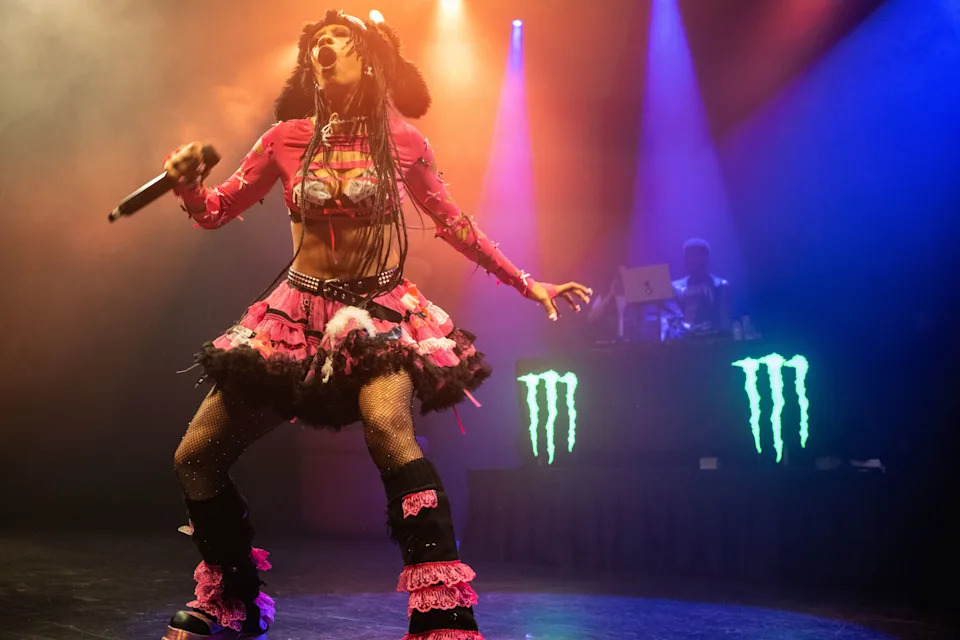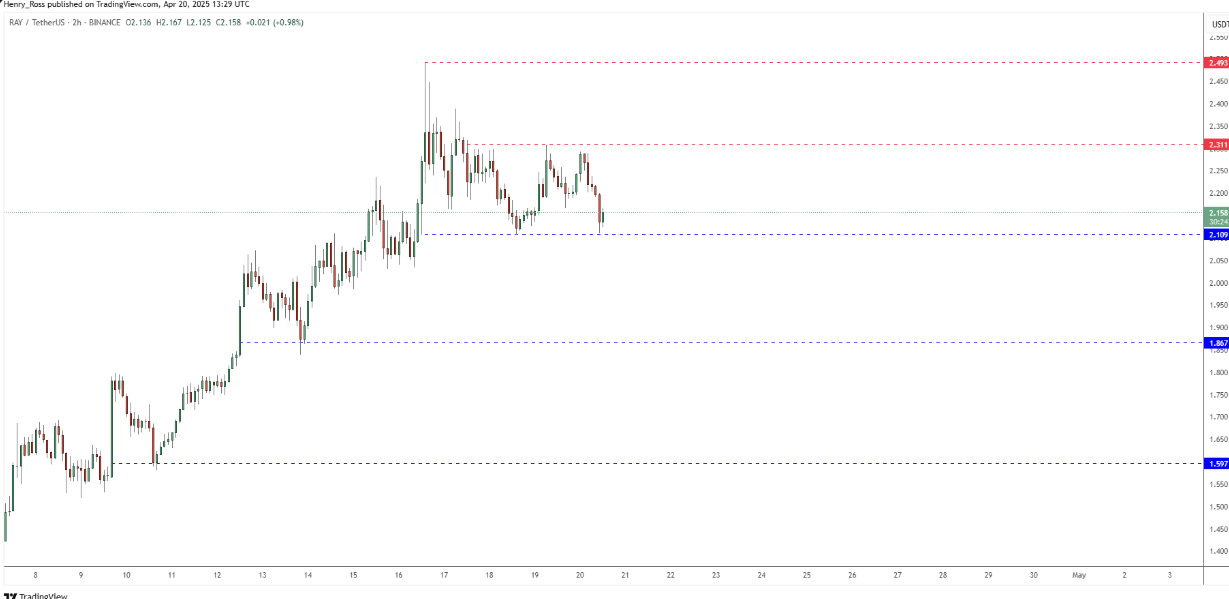Rico Nasty, master of rage rap, awakened her B-side. It's lethal.
 Yahoo is using AI to generate takeaways from this article. This means the info may not always match what's in the article. Reporting mistakes helps us improve the experience.Generate Key Takeaways
Yahoo is using AI to generate takeaways from this article. This means the info may not always match what's in the article. Reporting mistakes helps us improve the experience.Generate Key TakeawaysRico Nasty seems to feel the need to explain herself.
Late last month, the musician who made a name for herself as a master of rage rap strutted into a crowded room in a black latex bikini top and pants shredded up to her hips. At the microphone she launched into the kind of leathery, full-throttle verse she’s known for, demanding the assembled crowd — miniskirted, neon-haired, snakeskin-clad members of the Nasty Mob — to answer back.
“Who want it?” she called.
AdvertisementAdvertisement#«R24ekkr8lb2m7nfddbH1» iframe AdvertisementAdvertisement#«R44ekkr8lb2m7nfddbH1» iframe“Who want it,” they echoed, throbbing with the beat.
But the rapper hadn’t assembled this sliver of the Nasty Mob at a club or concert venue or an underground party. She’d brought them here, to the headquarters of NPR, to watch her perform a Tiny Desk concert in front of a distinctive, overstuffed bookcase.
She pounded through a few of her classics, including “Tia Tamera,” a track she’d recorded with Doja Cat, and her best known song, “Smack a B----.” Then she laughed nervously, sighed loudly and turned her palms to the ceiling.
“I have —,” she started and stopped.
Then: “Yeah, let’s go.”
Guitars swept in and Nasty closed her eyes and began to sing. “I need to crash out, can I borrow your bed? / And I’ll be all done, and I’ll be out of your head / You make it alright, l can’t control a thing.”
AdvertisementAdvertisement#«R2bekkr8lb2m7nfddbH1» iframe AdvertisementAdvertisement#«R4bekkr8lb2m7nfddbH1» iframeHer voice cracked on the song’s last line and Nasty cradled her face in her hands. “Whew!” she exhaled. “I’m not gonna lie y’all. That one I was scared.”
Until now every bit of success she’s claimed in this world came from toughness, an aptitude for irony and a shortage of [expletives] to give. The devotion of the Nasty Mob. A contract with Atlantic Records. High-profile collaborations, sold-out concerts, sparkling reviews.
Then she left Atlantic for a label best known as the home to White guy rockers like Fall Out Boy and Twenty One Pilots. She scrapped relationships with a slew of advisers and industry consultants.
She went dark for a long time before releasing a new album in May.
AdvertisementAdvertisement#«R2hekkr8lb2m7nfddbH1» iframe AdvertisementAdvertisement#«R4hekkr8lb2m7nfddbH1» iframeIt’s called “Lethal,” and it forces a question: What if it’s vulnerability, really, that’s lethal?
For everyone. But especially for Rico Nasty.
Maria-Cecilia Simone Kelly was born in Brooklyn. Her peripatetic childhood included stops around the Washington Beltway and a boarding school stint in Baltimore before a stretch of stability in Largo and at Charles Herbert Flowers High School. She got into drama club stuff, doing makeup and stage production.
As a sophomore in 2014 she started releasing tracks on SoundCloud as Rico Nasty. And people started listening, mostly to “Hey Arnold” and “iCarly” — remixes of saccharine theme songs from tween TV shows overlaid with funk and quick-witted rap prose. Soon Rico Nasty was glitching through the wired headphones of teenagers at bus stops and bumping out of janky speakers at DMV house parties that sprung up when someone’s parents left town.
AdvertisementAdvertisement#«R2mekkr8lb2m7nfddbH1» iframe AdvertisementAdvertisement#«R4mekkr8lb2m7nfddbH1» iframeNasty was rapping of them, for them and making low-budget music videos in their actual backyards. She got invited to perform at Sweet 16 parties and small club gigs, where she’d give out merch, making sure her name was known.
 Rico Nasty performs onstage at the Fillmore Silver Spring in 2023. - (Kyle Gustafson/For The Washington Post)
Rico Nasty performs onstage at the Fillmore Silver Spring in 2023. - (Kyle Gustafson/For The Washington Post)“You look back on situations and think like, f---, that was horrible, that was grind,” Nasty, now 28, says in a Zoom interview with The Washington Post. “I didn’t have no money, but, like, low-key that was the best part.”
“Rico, Rico, Rico, yuh,” became her call sign, spotted through a signature static-laced, auto-tuned style, relatable aggression, and unpolished, caustic lyrics.
In 2018, at age 21, Atlantic Records called and she answered. By then she was mom to a toddler son. After gaining recognition from her single “Smack a B----,” and signing with the label, she released a few mixtapes including, “Nasty” and “Anger Management” in collaboration with Kenny Beats. As she moved on to studio albums, the Nasty Mob multiplied.
AdvertisementAdvertisement#«R2sekkr8lb2m7nfddbH1» iframe AdvertisementAdvertisement#«R4sekkr8lb2m7nfddbH1» iframeNasty described her style as “sugar trap” and trademarked the term. In one interview she defined it with a metaphor: “It’s like when you have a really, really bad life and s--- good starts happening and you don’t know how to adapt to the good s---.”
She headlined her own tours. Appeared in the Lil Nas X music video for “Old Town Road.” Performed during New York Fashion Week and on the “Tonight Show Starring Jimmy Fallon.” Earned the praise of critics who appreciated her particular lethality as much as fans.
And then the blasts died off.
These days Rico Nasty talks a lot about her Saturn return. It’s an astrological reference that describes a period of maturation that typically occurs at age 27 or 28, bringing significant challenges that herald the responsibility of true adulthood. It’s not fun.
AdvertisementAdvertisement#«R31ekkr8lb2m7nfddbH1» iframe AdvertisementAdvertisement#«R51ekkr8lb2m7nfddbH1» iframeFor her, it meant investigating the angry facade and image she had curated over the years.
“It kind of gets to a point where, you know, you’re suppressing a lot of s--- and yeah, you just want to talk about it,” she says. “Therapy helped me to talk about stuff and maybe not be afraid of the reaction.”
It also meant dropping some of the trappings on which she’d built her career, even if that put her in danger of losing the beautifully messy niche she built.
After cutting ties with Atlantic Records in 2022, she signed with Fueled by Ramen, a move that early fans may not have chosen for her, though it was previously home to Paramore, rockers she frequently points to as an inspiration. (Fueled by Ramen is distributed by Atlantic.)
AdvertisementAdvertisement#«R36ekkr8lb2m7nfddbH1» iframe AdvertisementAdvertisement#«R56ekkr8lb2m7nfddbH1» iframeAs Nasty explains it, she reached her limit. She wanted to make the music that she liked and that made her feel good. She could no longer hold her less-venomous tongue; She had things to say, softly.
“I felt like my music is like very, very aggressive and I feel like it can bring aggressive energy that’s like ‘You get too old for that s---,’” she says. “You get too old for it to just be, like, your whole promo is just beef.”
Nasty discovered the B-side of her persona, but the transformation seems more like a de-escalation, wading her back into the real Nasty. To get there, for this album, she disciplined herself so the music could shine. She started the process with a handful of hired creative directors and then scrapped them. In Los Angeles, she recut and re-edited her work so that it fit her standards in a grand mission to not revert to the days of “Anger Management” and “Nightmare Vacation” (her earlier mixtape and album, respectively). Back then, she says, she hired people to bring her ideas to life, and in doing so withered away, becoming “far-removed” from her craft.
Armed with mood boards, palettes and a glam squad, she “damn near” became the production team for the album process.
AdvertisementAdvertisement#«R3bekkr8lb2m7nfddbH1» iframe AdvertisementAdvertisement#«R5bekkr8lb2m7nfddbH1» iframe“I think in making this album, I really tapped into not being afraid for things to sound completely perfect,” she said. “Lyrically, I wasn’t like trying to be the best f---ing rapper, I was just kind of trying to get off what I wanted to say.”
During the same stretch she also reverted back into the drama club world with a debut acting role in Apple TV+’s “Margo’s Got Money Troubles,” where she plays KC. After pursuing acting during the pandemic out of fear the music world might never be the same, she finally landed a role.
But now she’s in the process of revealing her post-Saturn-return self to the world. She is wildly different from the girl she was on SoundCloud, or the 20-year-old she was when she introduced “Sugar Trap.” And with change being a great catalyst for discomfort, she may feel the gaze of her OG fans acutely. In her Tiny Desk performance an eagerness for approval floated off of her as she opened herself up and played the slower, less nasty songs.
She is sure, at least, that she knows now what she wants of her music. What she wants to give her mob, nasty or not. “I really just wanted to be fun,” she says. “I feel like I wanted to be, like, an experience.”
AdvertisementAdvertisement#«R3gekkr8lb2m7nfddbH1» iframe AdvertisementAdvertisement#«R5gekkr8lb2m7nfddbH1» iframeShe wants, she adds, “to bring the weirdos together.”
They were there, at NPR, in pink platform heels with lacy white socks, extra-chunky black boots with silver spikes, blue and pink hair, a muted yellow shirt unmuted by its obnoxious snakeskin pattern, plus one guy giving definite RoboCop vibes.
And when Nasty opened her eyes while singing that aching new song, “Crash,” she must’ve noticed something striking: Her fans were already singing along.













